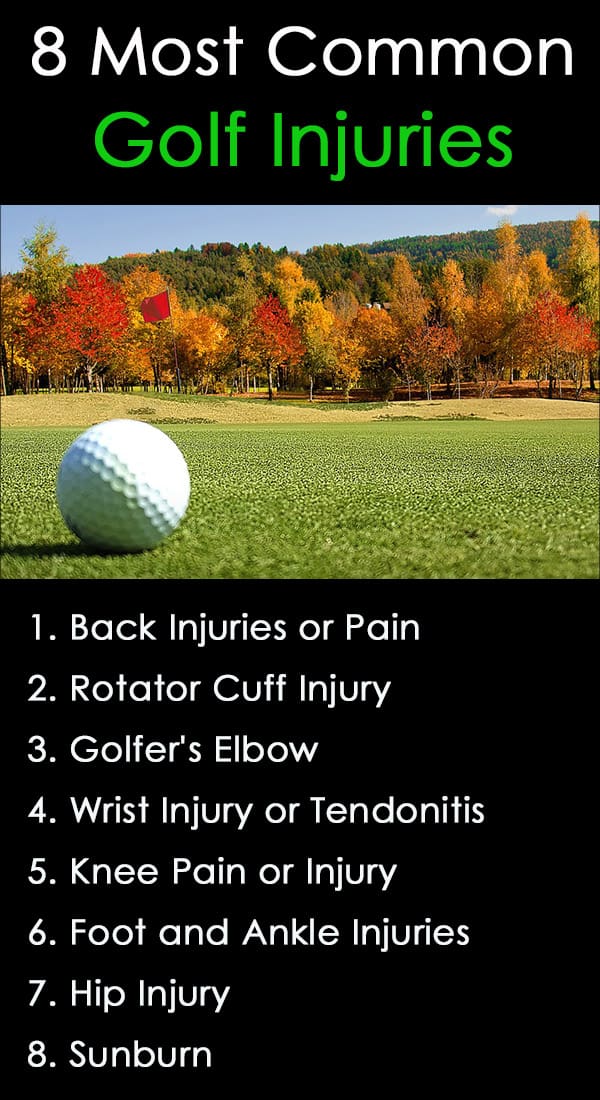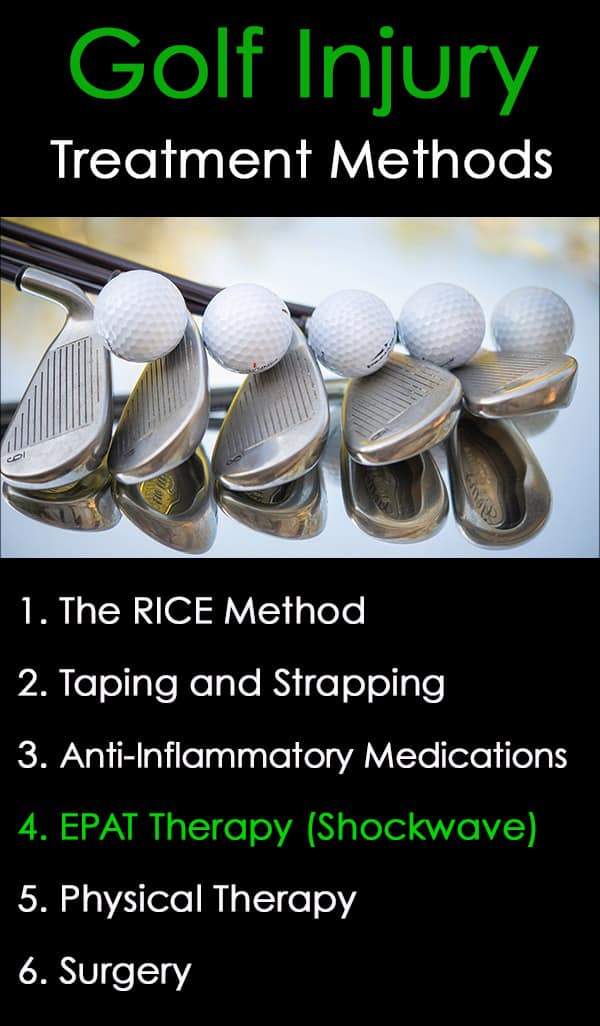Understanding the most common golf injuries can help those who love playing the sport prevent an injury before it ever happens, or know what the most effective treatments are for a faster recovery.
From an outsider’s perspective, golf may seem like a sport that comes with little risk of injury. It is after all, a low impact, non-contact activity. But as any golfer who hits the links on a regular basis can tell you, the sport comes with its own special brand of aches and pains.
Sudden oncoming golf injuries, like sprains and strains are certainly a factor for golfers, though these types of issues may be less likely than for athletes in higher-impact sports.
What’s more common are injuries that come from repetitive movements, poor mechanics and form, or soft tissue tears that go unnoticed at first, but then gradually become an issue with repeated stress.
Age also plays a role in some of the golf injuries outlined here. With many golfers playing at a later age than most other sports, it’s not unusual for the body’s time clock to kick in at some point.
8 of the Most Common Golf Injuries
When examining the movements involved in golf, from the body’s rotation in the swing, to a player’s grip and foot placement, it makes sense that many of the most common golf injuries are in the joints and of course, the lower back.
1. Golf Back Injuries or Pain
A full round of 18 holes of golf has players hunched over their ball and lining up their shot before swinging over the course of four to five hours. Amateur golfers know too well that unlike the pros, it often takes more than two to three swings to get from the tee to the green.
The repeated stress of rotation in the swing can create serious lower back pain and strain. Proper technique is key, but so is a strong abdominal core that can endure the continued intensity of several hours’ worth of swinging.
Keeping the back limber by stretching and warming up before playing will also help protect against common golf back injuries.
For those who carry their clubs on the course instead of using a cart, upper back pain can be a problem just like lower back injuries.

2. Rotator Cuff Injury
The group of muscles and tendons surrounding the shoulder joint and keeping it firmly in place is known as the rotator cuff. In particular, the supraspinatus tendon is at risk for developing rotator cuff tendonitis (supraspinatus tendonitis).
Like the lower back, the rotator cuff is forced to absorb continued stress with every golf swing and that can cause micro-tears, bursitis, and outright ruptures in the grouping of soft-tissue.
Rotator cuff pain may even be felt after a round of golf is played. Athletes with this injury usually experience a sensation of weakness, along with pain and discomfort, as well as finding it difficult to extend the arms overhead.
3. Golfer’s Elbow
Known medically as medial epicondylitis, golfers elbow is a condition that leads to inflammation and soreness where the forearm tendons and muscles attach to the bone, causing inner elbow pain.
The pain associated with golfer’s elbow can range from mild to severe and may firmly impact a person’s ability to play the sport if not treated properly.
While the injury can develop from sudden trauma, in golfers it is usually the result of repetitive stress on the tendons in the forearm.
4. Golf Wrist Injury Like Tendonitis
Referred to as tenosynovitis, wrist tendonitis occurs when the long strands of fibrous tissue that run throughout the forearm and connect the hand to the bone became inflamed and painful.
This may be an easy condition to ignore at first because as the soft tissue in the wrist and forearm gets warmer, the pain is likely to dissipate. But that doesn’t mean the condition won’t worsen.
Left untreated, symptoms like pain, stiffness and poor range of motion will present in the hand as well as on the top and bottom of the wrist.
5. Knee Pain or Injury
A golfers outer knee, whether they are a right-handed player or a left-handed player, is put under a lot of stress as it stabilizes the hips through the rotation of the golf swing. Over time, the stress can cause ligaments to tear in the knee, creating inflammation, pain, and weakness.
It should be noted that because golf is low-impact, the sport is favored by a lot of retirees. As we age, the movements in golf can exacerbate wear and tear on the knee, as well as contributing to arthritis in the knee.
Developing a strong core and doing some strength training and stretching in the muscles surrounding the knee is always a good preventative practice.
6. Foot and Ankle Injuries
Because the body essentially operates like a whip in a golf swing, the power needed to generate that force starts in the feet. Each foot and ankle ends up in a different position at the end of a golf swing.
Proper form is key, but the repeated pressure of generating power from the feet and ankles can cause issues such as ankle tendonitis (peroneal tendonitis).
Sprains, strains, tendonitis, and inflammation in the feet and ankles can be common in golf. The fact that a lot of players prefer to walk the course has a big impact on pain and injuries to the feet and ankles.
As any seasoned golfer will tell you, proper fitting shoes are essential, not just to protect the feet and ankles, but to avoid nagging, painful blisters.
7. Golf Hip Injury
The hip joint is generally very robust and strong, carrying most people wherever they need to go, but during golf, it takes a beating. In a golf swing, the hip starts in a bent position and then moves away from the midline point of the body – abduction – before returning.
Hip tendinitis (hip flexor tendonitis), inflammation, pain, and micro-tears in the hip soft-tissue are all common golf injuries.
Maintaining strong gluteal, abdominal, and leg muscles are recommended for golfers. Weakness in these muscles can increase the chances of hip injuries, groin strains, and lower back issues.
8. Sunburn
It’s easy to overlook the sun as a factor in golf injuries. That said, the skin is the largest organ of the human body and even on an overcast day it can get seriously burned.
Sunscreen, hats, and clothing that cover the body are always recommended. Staying hydrated with water and cutting back on alcohol can help speed recovery for a bad sunburn.
6 Treatment Methods For Common Golf Injuries
Treatment methods for golf injuries will vary depending on the type and severity of the issue. However, these 6 treatment methods can be effective for many types of golf injuries.
1. The RICE Method
RICE stands for Rest, Ice, Compression and Elevation. The RICE Method is a conservative approach that works for minor strains, muscle pain, and other issues. RICE works best when used within in the first few days of developing an injury.
Ice can help decrease inflammation and pain, while compression on the affected area will provide support, and resting the injured area gives it time to heal. Whenever possible, elevating the injured area above the heart is recommended.
2. Taping and Strapping Golf Injuries
Taping and strapping can help support areas like elbows and knees, as well as reducing stress for other soft-tissue and muscles by providing extra tension.
Some golfers will tape injury-prone areas in an effort to avoid injuries from happening. This might also help a golfer with a minor strain continue to play through the injury.
Many golfers tape their fingers to avoid blisters and cushion the fingers to help with their grip.

3. Nonsteroidal Anti-Inflammatory Medications
Over-the-counter pain medications, such as nonsteroidal anti-inflammatory medications like ibuprofen (Advil), can minimize pain related to an injury and aids in decreasing inflammation.
Depending on the injury, some golfers may require a steroidal injection for serious inflammation or pain, although many doctors now recommend alternatives to cortisone shots.
4. EPAT Therapy (Shockwave)
EPAT Therapy is a painless, noninvasive method to speed up the body’s natural healing process for many types of golf injuries. EPAT uses low or high impulse pressure waves delivered into the muscles and tissue to increase blood flow and reduce inflammation.
Also known as Extracorporeal Shock Wave Therapy ESWT, this is a safer alternative to surgery or other invasive techniques because there is no scaring or risk of infection.
EPAT or ESWT therapy sessions can be delivered while many people continue to play depending on the injuries.
5. Physical Therapy
For many types of injuries, physical therapy has shown to be an effective way of strengthening the injured area while recovering. It can also help people learn proper form and techniques to reduce the risk of another golf injury.
Combining physical therapy with other treatment approaches such as EPAT Therapy can speed up injury recovery and decrease downtime to get golfers back on the course more quickly.
6. Surgery for Golf Injuries
Typically, surgery is a last resort for treating most common golf injuries, unless it is necessary after trying other conservative methods. Some severe types of knee or hip injuries can only be repaired with surgery.
Unfortunately, surgery requires longer recovery times and other complications due to its invasive nature. A surgeon or sports medicine professional will outline the risks and recommendations.
Except for the possibility of sunburn, most people rarely ever think about a golf injury unless it happens to them. Even at the first sign of an injury, many people continue playing until the pain becomes so bad it’s difficult to keep playing.
Understanding some of the most common golf injuries and knowing how to prevent or treat them will allow golfers to stay on the course longer and out of the clubhouse while others play.